Chrysler 300 non-letter series
The Chrysler 300 (Chrysler 300 Non-Letter Series) was a full-size automobile produced by Chrysler from 1962 until 1971. It was the replacement for the 1961 Chrysler Windsor, which itself filled the place in Chrysler's line previously occupied by the Saratoga just the year before that (1960). At the time, it was considered a luxurious "muscle car", with all the performance of the Dodge and Plymouth products of the time, but with the luxury features expected of the Chrysler name.
| Chrysler 300 | |
|---|---|
.jpg) 1971 Chrysler 300 | |
| Overview | |
| Manufacturer | Chrysler Corporation |
| Production | 1962–1971 |
| Assembly | Detroit, Michigan, United States |
| Body and chassis | |
| Class | Fullsize car |
| Body style | 4-door hardtop 2-door hardtop 2-door convertible |
| Layout | FR layout |
| Related | Imperial Chrysler New Yorker Chrysler Newport Chrysler Saratoga |
| Chronology | |
| Predecessor | Chrysler 300 letter series |
| Successor | Chrysler Cordoba |
The 300 was positioned as a cheaper rendition of the 300 "letter series", and a sporty variant of a full-size automobile, adding 4-door hardtop version and running alongside that model until its discontinuation in 1966. It became the sole 300 model until 1971, when production ended. The 300 name returned to the Chrysler line in 1979 as an option package on the Cordoba coupe.
1962–1964
| Chrysler 300 1962–1964 | |
|---|---|
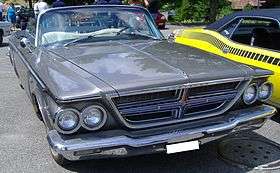 1964 Chrysler 300 | |
| Overview | |
| Production | 1962–1964 |
| Body and chassis | |
| Body style | 4-door hardtop 2-door hardtop 2-door convertible |
| Platform | B-body |
| Powertrain | |
| Engine | 383 cu in (6.3 L) B V8 413 cu in (6.8 L) RB V8[1][2] |
| Transmission | 3-speed automatic 3-speed manual |
| Dimensions | |
| Wheelbase | 122 inches (3,100 mm) |
| Length | 215.3 inches (5,470 mm) |
| Width | 79 inches (2,000 mm) |
| Height | 55 inches (1,400 mm) |
| Curb weight | 3,970 pounds (1,800 kg) (4-door hardtop)[3] |
The non-letter series was introduced in 1962; it expanded the letter series on the 4-door hardtop, adding 383 V8 as a choice (letter cars had 413 V8 as standard).[4]
For Canadian market there was similar Chrysler Saratoga offered instead, also as a 4-door sedan, from 1964 named Chrysler Saratoga 300 and bearing a similar trim.[5]
- 1962 Chrysler 300 4-door hardtop
 1963 Chrysler 300 convertible
1963 Chrysler 300 convertible.jpg) 1964 Chrysler Saratoga 300 (Canadian) 4-door hardtop
1964 Chrysler Saratoga 300 (Canadian) 4-door hardtop
1965–1968
| Chrysler 300 1965–1968 | |
|---|---|
1965 Chrysler 300 Convertible | |
| Overview | |
| Production | 1965–1968 |
| Body and chassis | |
| Body style | 4-door hardtop 2-door hardtop 2-door convertible |
| Platform | C-body |
| Powertrain | |
| Engine | 383 cu in (6.3 L) B V8 413 cu in (6.8 L) RB V8 440 cu in (7.2 L) RB V8[6] |
| Transmission | 3-speed automatic 4-speed manual |
| Dimensions | |
| Wheelbase | 124 inches (3,100 mm) |
| Length | 218.2 inches (5,540 mm) |
| Width | 79.5 inches (2,020 mm) |
| Height | 54.9 inches (1,390 mm) |
| Curb weight | 4,390 pounds (1,990 kg) (4-door hardtop)[7] |
In 1966, the Chrysler 300 letter series was discontinued, the 440 V8 replaced the 413 V8, and there was a mild facelift.[8]
1967 brought makeovers which changed front and rear styling extensively. The 4-door sedan was dropped from lineup (leaving the 4-door hardtop), the 440 V8 became standard and only available powerplant in two guises: base and more powerful TNT. 1968 facelifting brought concealed headlamps which were to be 300 trademark until 1971.[9]
.jpg) Canadian 1965 Chrysler Saratoga 300 4-door sedan
Canadian 1965 Chrysler Saratoga 300 4-door sedan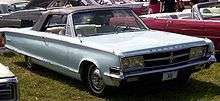 1965 Chrysler 300 convertible
1965 Chrysler 300 convertible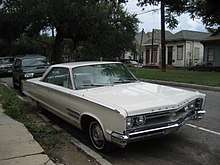 1966 Chrysler 300 2-door hardtop
1966 Chrysler 300 2-door hardtop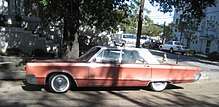 1967 Chrysler 300 4-door hardtop
1967 Chrysler 300 4-door hardtop- 1968 Chrysler 300 2-door hardtop
 1968 Chrysler 300 convertible
1968 Chrysler 300 convertible
1969–1971
| Chrysler 300 1969–1971 | |
|---|---|
.jpg) 1971 Chrysler 300 | |
| Overview | |
| Production | 1969–1971 |
| Body and chassis | |
| Body style | 4-door hardtop 2-door hardtop 2-door convertible |
| Platform | C-body |
| Powertrain | |
| Engine | 440 cu in (7.2 L) RB V8 440 cu in (7.2 L) TNT V8[10] |
| Transmission | 3-speed automatic |
| Dimensions | |
| Wheelbase | 124 inches (3,100 mm) |
| Length | 224.7 inches (5,710 mm) |
| Width | 79.1 inches (2,010 mm) |
| Height | 55.6 inches (1,410 mm) |
| Curb weight | 4,320 pounds (1,960 kg) (4-door hardtop)[11] |
1969 was first year for "fuselage styling", there were two engine options; 440 and 440 TNT.[12][13]
For 1970, taking a cue from Oldsmobile, a Hurst 300 was offered in Spinnaker White trimmed in Satin Tan with leather interior (pilfered from the Imperial), powered by a 375 hp (280 kW) 440 cu in (7.2 l) TNT V8, as a limited edition of 485.[14] The single convertible built used a standard Chrysler 300 white interior.
In 1971, the convertible was no longer offered, as Chrysler halted production of convertibles across the entire lineup in 1971.[15]
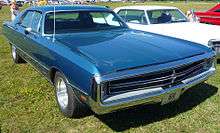 1969 Chrysler 300 4-door hardtop
1969 Chrysler 300 4-door hardtop- 1969 Chrysler 300 convertible
- 1970 Chrysler 300 Hurst 2-door hardtop
.jpg) 1971 Chrysler 300 2-Door Hardtop
1971 Chrysler 300 2-Door Hardtop
Engines
| engine displacement, type, carburetor type | max. motive power at rpm | max. torque at rpm |
|---|---|---|
| 440 cu in (7.2 L) RB V8 (1971) 4-barrel | 335 bhp (250 kW; 340 PS) [220 bhp (164 kW; 223 PS)] @ 4,400 [4,000] | 460 lb⋅ft (624 N⋅m) [350 lb⋅ft (475 N⋅m)] @ 3,200 |
| 440 cu in (7.2 L) RB V8 (1969–1970) 4-barrel | 350 bhp (261 kW; 355 PS) @ 4,400 | 480 lb⋅ft (651 N⋅m) @ 2,800 |
| 440 cu in (7.2 L) TNT V8 (1971) 4-barrel | 370 bhp (276 kW; 375 PS) [305 bhp (227 kW; 309 PS)] @ 4,600 | 480 lb⋅ft (651 N⋅m) [400 lb⋅ft (542 N⋅m)] @ 3,200 |
| 440 cu in (7.2 L) TNT V8 (1968–1970) 4-barrel | 375 bhp (280 kW; 380 PS) @ 4,600 | 480 lb⋅ft (651 N⋅m) @ 3,200 |
| [ ] denoting net figures [10][16] | ||
1979
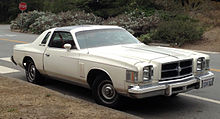
The 300 name returned to the Chrysler line in the spring of 1979; this time based on the Cordoba coupe. The 300 was a $2,040 option package featuring special emblems and traditional "cross-hair" 300-style grille.[17] It was available in Spinnaker White (perhaps 30 were painted Rallye Red) with a red-leather interior and red pin stripes. The model came with the code E58 195 hp (145 kW; 198 PS) 360 cu in (5.9 L) V8, featuring a four-barrel carburetor, a performance camshaft, and dual exhausts. Other features included police-spec suspension with 15"x7" wheels, heavy duty torsion bars/leaf springs/shocks, front and rear sway bars, and a 3.23 rear gear ratio. The deteriorating U.S. domestic economic conditions that led to the early 1980s recession reflected in low demand and less than 2,900 were built. The 300 model was planned for the 1980 model year using the new 2nd-generation Cordoba (based on the downsized Chrysler J platform), but was instead called the "LS".
Notes
- History Of the Chrysler Three Hundred Series – 1962 Archived 2012-05-21 at the Wayback Machine. Chrysler300site.com (2000-05-31). Retrieved on 2013-05-11.
- History Of the Chrysler Three Hundred Series – 1964 Archived 2012-07-17 at the Wayback Machine. Chrysler300site.com (1999-09-16). Retrieved on 2013-05-11.
- "Archived copy". Archived from the original on 2013-01-17. Retrieved 2012-06-10.CS1 maint: archived copy as title (link)
- Chrysler 300 History and Gallery Archived 2012-05-21 at the Wayback Machine. Chrysler300site.com (2000-05-31). Retrieved on 2013-05-11.
- Chrysler 1964. Chrysler Canada Ltd., 1964
- Chrysler 300 History and Gallery Archived 2012-03-21 at the Wayback Machine. Chrysler300site.com (2000-01-18). Retrieved on 2013-05-11.
- "1965 Chrysler 300 4-Door Hardtop Firepower-315". Archived from the original on January 17, 2013. Retrieved June 10, 2012.
- Chrysler C Bodies: The Big Guys. Allpar.com. Retrieved on 2013-05-11.
- Chrysler 300 History and Gallery Archived 2012-07-17 at the Wayback Machine. Chrysler300site.com (1998-12-12). Retrieved on 2013-05-11.
- "1971 Chrysler Features". Oldcarbrochures.com. p. 28. Retrieved 20 January 2014.
- "1969 Chrysler Data Book". Oldcarbrochures.com. Retrieved 20 January 2014.
- 1969 Chrysler. Fuselage.de. Retrieved on 2013-05-11.
- Chrysler 300 History and Gallery Archived 2012-03-21 at the Wayback Machine. Chrysler300site.com (2001-02-18). Retrieved on 2013-05-11.
- Flory, J. "Kelly", Jr. American Cars 1960–1972 (Jefferson, NC: McFarland & Coy, 2004), p.734.
- Chrysler 300 History and Gallery Archived 2012-03-21 at the Wayback Machine. Chrysler300site.com (1998-12-12). Retrieved on 2013-05-11.
- "1969 Chrysler Data Book". Oldcarbrochures.com. Retrieved 20 January 2014.
- Auto Editors of Consumer Guide (16 July 2007). "1979-1982 Chrysler Cordoba 300/Cordoba LS". HowStuffWorks.com. Retrieved 20 January 2014.